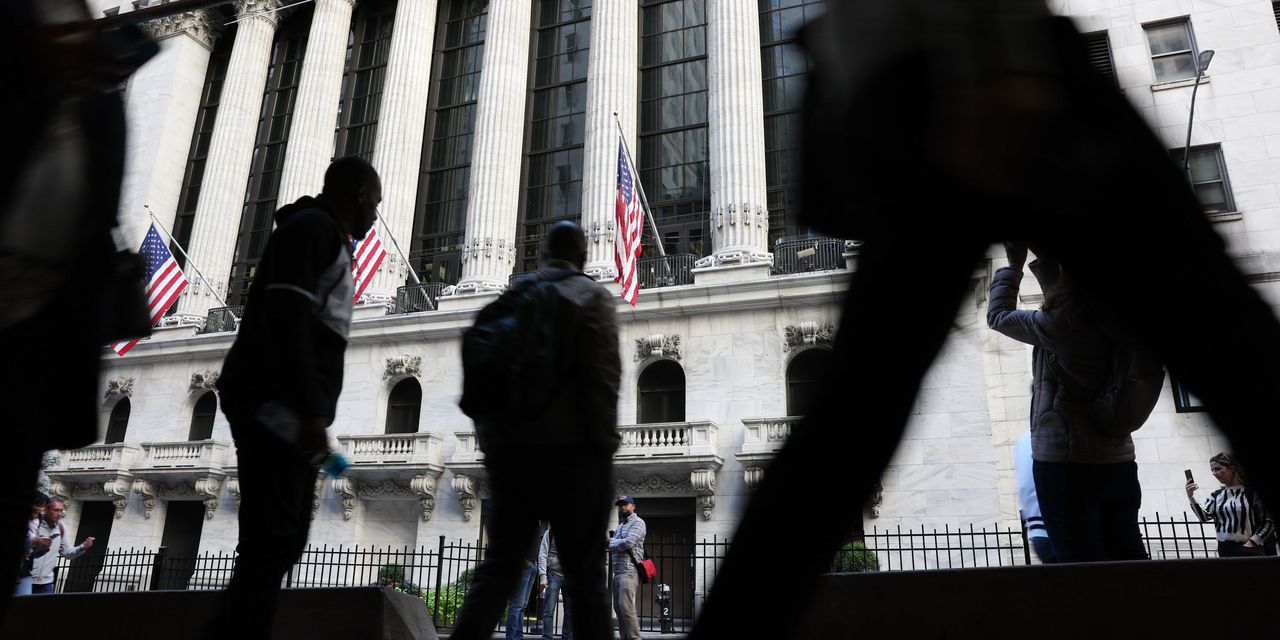U.S. stocks tumbled on Monday as protests in China raised the risks to global growth and Federal Reserve policy makers said more interest-rate increases are needed to control inflation.
How stocks are trading
- The Dow Jones Industrial Average was down 456 points, or 1.3%, at 33,891, near its session low.
-
The S&P 500
SPX,
-1.64%
retreated 61 points, or 1.5%, to 3,966. - The Nasdaq Composite shed 181 points, or 1.6%, dropping to 11,046.
U.S. stocks had notched weekly gains last week for the second time in three weeks. The Dow rose 1.8%, the S&P 500 advanced 1.5% and the Nasdaq gained 0.7%.
What’s driving markets
Wall Street started the week in a downbeat mood as traders absorbed the impact of unrest in China and assessed interest-rate commentary by a pair of Fed officials on Monday.
St. Louis Fed President James Bullard told MarketWatch that he favors more aggressive interest-rate hikes to contain inflation and that interest rates will likely need to stay elevated for all of 2023 and into 2024. Meanwhile, his colleague John Williams, president of the New York Fed, said that “we’re going to need to raise rates further from where we are today” and keep restrictive policy in place “for some time,” though he said borrowing costs could start to come down in 2024.
Overseas, Hong Kong’s Hang Seng Index HK:HSI closed down by 1.6% and most equity indexes across Asia also fell, with the exception of India’s, on concerns about unrest in China. Those concerns also spilled over into commodity markets, with West Texas Intermediate crude for January delivery CLF23 briefly falling more than 3% to less than $74 per barrel before bouncing back. Meanwhile, copper prices HG00 were off 0.6% at $3.605 per pound.
“What people are worried about is the potential for protests in China to spread and whether the population is reaching its breaking point,” said Derek Tang, an economist at Monetary Policy Analytics in Washington. “At the same time, Fed speak is ramping up and the message is there’s more hikes to come. So investors aren’t finding relief.”
Signs that economic activity in China will continue to be disrupted by the protests or by additional anti-COVID measures will likely continue to weigh on commodity prices, analysts said. Meanwhile, earlier on Monday, concerns about global growth helped to support government bond markets, where the yield on the 10-year note
TMUBMUSD10Y,
briefly traded at its lowest level since October.
The unprecedented waves of protest in China “have caused ripples of unease across financial markets, as worries mount about repercussions for the world’s second-largest economy,” said Susannah Streeter, senior investment and markets analyst at Hargreaves Lansdown. “As demonstrations spread across the country from Beijing to Xinjiang and Shanghai, reflecting rising anger about the zero-Covid policy, a sustained recovery in demand across the vast country appears even further away.”
But the news wasn’t all bad: Reports of strong online Black Friday sales helped boost shares of Amazon.com Inc.
AMZN,
which were up 0.7%.
Investors can expect more information about the health of the U.S. economy in what’s shaping up to be a busy week for U.S. economic data: Later this week, investors will receive the ADP employment report followed by the November jobs report. Revised data on third-quarter gross domestic product is due on Wednesday, along with the Fed’s Beige Book report. Federal Reserve chair Jerome Powell is set to speak publicly on Wednesday, and a closely watched gauge of inflation is due on Thursday.
Read: ‘We see major stock markets plunging 25% from levels somewhat above today’s,’ Deutsche Bank says
Single-stock movers
-
Shares of Apple Inc.
AAPL,
-2.82%
were down 2.8% amid reports of a production shortfall of as many as 6 million iPhone Pros. -
Activision Blizzard Inc.
ATVI,
+1.96%
shares traded 1.5% higher as Wall Street analysts said the stock looked undervalued even if Microsoft Corp.
MSFT,
-2.48%
doesn’t receive clearance for its buyout. -
Class A shares of DraftKings Inc.
DKNG,
-4.92%
tumbled 5.1% after J.P. Morgan analyst Joseph Greff turned bearish on the online-sports-betting and fantasy-sports company. -
Shares of some of China’s biggest technology companies saw their U.S.-traded shares surge on Monday despite the unrest at home. Shares of Alibaba Group
BABA,
+0.52%
and Tencent Holdings
TCEHY,
+2.23%
were up 1% and 1.1%, respectively, while the KraneShares CSI China Internet ETF
KWEB,
+3.77%
was 3.6% higher.
— Jamie Chisholm contributed to this article.


